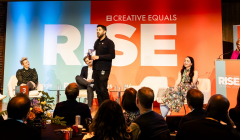
Are we leaving men and boys behind?
At Creative Equal’s RISE event, industry leaders consider how to reframe boys and men in marketing

Inclusive media planning can ensure that diversity and representation are executed in every stage

Diversity, equity, and inclusion (DE&I) have always been central to the advertising industry. However, in previous years the focus has been on recruitment and representation at events, or in content. However, in reality, diversity is a lot more than hiring processes, or representational panels.
Consumers know when a brand is simply posturing, and are far less likely to buy from those which don’t authentically match their social views. Even brands with the best of intentions can struggle to show their true colours due to a lack of know-how. Getting this wrong could compromise brand safety and customer loyalty.
Whilst International Women’s Day is a good reminder for brands, it should not be a one-day celebration for advertisers. By defining what diversity means to your brand, auditing your blocklists, and developing a diverse media plan brands can deliver on long-term diversity promises with authenticity and commitment.
When a brand begins the journey toward a diversified media plan, it must start by first defining what it means to the business. Does it mean engaging with a more diverse range of groups? Does it mean more diversity in your creative? Or does it mean supporting different media outlets?
Representation where decisions are being made is just as important as representation in media.
Carlye King, Co-chair of the Women’s Network EMEA and Account Manager, Agencies at Xandr
Once those questions are answered, it’s time to explain the definition to your partners so that they can help you to activate against those parameters. Having an honest dialogue with your partners across the industry is the only way to move the needle forward, this cannot be a solitary effort. If you’re looking to support minority-owned and smaller niche publishers, your tech partners can provide the technology to alleviate concerns you may have around fragmentation and scale.
One of the other major problems brands face when it comes to ensuring their media plans are diverse is their outdated approaches to keyword blocklists and brand safety.
Keyword blocklists often end up blocking brand-safe content and certain communities that brands should be looking to reach and, as a result, tend to be at odds with any type of diverse media planning. Brands shouldn’t stop at socially conscious messaging and values. Instead, an audit of your keyword blocklists in the demand side platform (DSP), or even removal altogether in lieu of more contextually progressive solutions, is vital for an authentically diverse media plan.
The ideal time for brands to start thinking about aligning their diversity strategy across their business was yesterday… But now is the next best time.
Carlye King, Co-chair of the Women’s Network EMEA and Account Manager, Agencies at Xandr
Ultimately, an inauthentic strategy is as good as not having a strategy at all, if you’re failing to actually engage with the communities you’ve set out to engage with.
Once you’ve got the definition, the curation, and the blocklists sorted, it then all comes down to your creative execution – ensuring your messaging is genuine and authentic. It’s important that your creative is personalised depending on the audience you’re targeting, and you need to be testing to see what works. The best way to ensure authenticity is to guarantee that the creative teams are as diverse as the audiences you are trying to reach. Representation where decisions are being made is just as important as representation in media.
For instance, you may be looking to engage with women’s-focused media properties. A possible solution here would be combining those properties into a one deal ID, making it easier to buy inventory across these titles. This allows media buyers to build a private SSP and leverage assets within a broad ad exchange, making it easier to test and learn efficiently and at scale.
This also creates an element of additional transparency. The open internet primarily exists because of advertising, take it away and publishers are forced to put all of their content behind subscription walls. This may benefit the larger publishers that can draw from a larger pool of potential subscribers, but smaller publications will fail as a result. An ad-funded model ensures there is diverse content on the internet across publications of different sizes and interests.
Further, curation means that brands are able to see where their ads are actually running and identify how much money they are putting into these minority-owned and smaller publications.
The ideal time for brands to start thinking about aligning their diversity strategy across their business was yesterday. But now is the next best time, and your media plans are a key part of that.
Beyond International Women’s Day, brands who want to prove that they’re truly diverse and inclusive should be engaging with all groups every day by integrating DE&I into the DNA of their campaign strategy.
Carlye King is Account Manager, Agencies at Xandr, AT&T’s advertising and analytics division. Prior to this role, Carlye was at the marketing research firm Nielsen. Alongside her work with agencies, Carlye is the co-chair for Xandr’s Women’s Network across EMEA. As part of the network, she inspires conversation and resolution on intersectional gender (in)equality across race and socioeconomic status.
Looks like you need to create a Creativebrief account to perform this action.
Create account Sign inLooks like you need to create a Creativebrief account to perform this action.
Create account Sign in